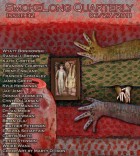In your bio, you mention mainly poetry publications. How did you become interested in flash fiction? And do you write longer fiction?
I became interested in flash fiction last year. I took a class in “experimental writing,” at Hollins University where I am an MFA candidate. We read and wrote flash fiction, prose poetry, creative autobiography, etc. Initially, I struggled with the genre, tending more towards lyric vignettes which didn’t meet the basic requirements for flash fiction. As the class progressed, however, I found that I really enjoyed the expansive nature of the form.
I read this several times, trying to understand the relationship of the narrator to Johnny. (In the end, I believe they are brothers.) What made it so difficult, I think, was that they didn’t seem to have a relationship to each other as much as to the drug. Is that a fair description?
That’s absolutely a fair assessment. They are brothers who share a tenuous relationship which revolves around addiction and abuse. I wanted to create distance between the narrator and Johnny, inviting the reader to draw the same conclusion you did. It has been my experience with addiction that many relationships, when viewed objectively, center on the substance in question and not anything meaningful or lasting. For me, the piece illuminates an aspect of addiction that I find so fascinating, namely, the notion that a relationship can be sustained for lengthy periods of time based on cursory interest in the other person. Ultimately, it is the drug that bridges the two brothers, not the fact that they are blood.
Both characters are using pretty heavily, but Johnny seems to suffer more consequences. Why is that, in terms of the story?
To begin, this is a great question. In writing this piece, I leaned heavily on my second hand experience with methamphetamines. I grew up and spent most of my life in rural Iowa, where it was not uncommon to hear on the local news of three or four labs busted in a single day or the theft of an anhydrous ammonia tanks from a neighbor’s field. At one point, Iowa was the meth capital of the world. To answer the question, I wanted to juxtapose both characters to show the arbitrariness of consequence. How do two people using the same drug suffer differently? How can the same drug alter and destroy one’s body more so than another? Is one person (character) willing to take more risks? Ultimately, Johnny suffers severe degradation of his body and suffers more consequences because someone always does.
Johnny’s getting straight seems to come suddenly, as a consequence of the beating. What do you predict for him? Will it last? And how about the narrator? Will he follow Johnny into sobriety?
I was told once by a friend who worked as a probation officer, that every addict or alcoholic has a bottom. For some, the bottom is an OWI or divorce, for others, something as simple as waking up with a violent hangover or losing a friendship or relationship. Johnny’s beating at the end of the piece is his bottom. Often times, the bottom does make sense to outside observers. How can Johnny suffer meth mouth, severe chemical burns, and hospitalization, yet commit to sobriety after a beating which pales in comparison to his previous ills? I predict that Johnny remains sober and the narrator follows suit.
Can you say something about the choice of language in this piece?
What I attempted to capture in this piece, which I feel I do in my poetry, is the rhythm and cadence of violence in its many manifestations. There are elements of traditional violence in this piece; however, I wanted to focus on the cadence of the language and alliterations and show how those rhythms affect our understanding of violence. The idea that violence has a rhythm or cadence may seem counter to many readers. For me, the notion that violence has a rhythm began in basic training: the cadence of boots while running or marching, the call and response between drill instructors and recruits, and the volley of gunfire on the rifle range. I began to recognize patterns and repeating sounds in basic training which stretched across the tenor of my enlistment. It wasn’t until I seriously began putting pen to paper that I realized I had smuggled that rhythm and cadence from the military into my writing. It has become unrecognizable for the most part, but it has certainly become a part of my aesthetic. It seems natural to assume that violence is brute and abstract, but in opposition to that ideology is the systemic and formulaic nature of military violence. The alliterations and cadence of this piece were not intentional; rather they are a manifestation and unintentional by-product of my military service.



 The core workshop of SmokeLong Fitness is all in writing, so you can take part from anywhere at anytime. We are excited about creating a supportive, consistent and structured environment for flash writers to work on their craft in a community. We are thrilled and proud to say that our workshop participants have won, placed, or been listed in every major flash competition. Community works.
The core workshop of SmokeLong Fitness is all in writing, so you can take part from anywhere at anytime. We are excited about creating a supportive, consistent and structured environment for flash writers to work on their craft in a community. We are thrilled and proud to say that our workshop participants have won, placed, or been listed in every major flash competition. Community works.